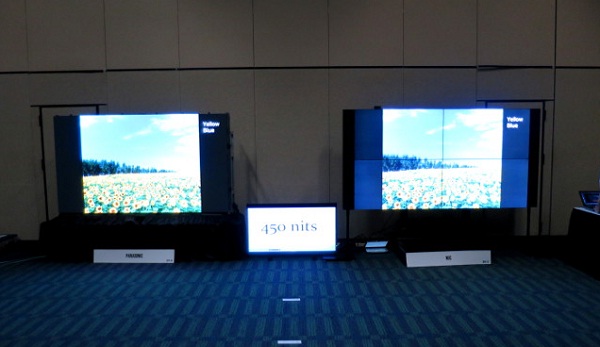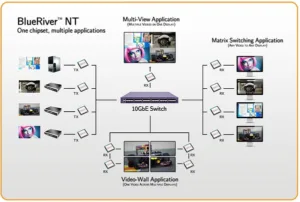We have covered Aptovision’s BlueRiver NT video transport system briefly before (VoIP from Aurora Multimedia and AptoVision), but Insight Media has written about the technology in much more detail recently.
BlueRiver is an FPGA-based video-over-IP product. It uses a standard ethernet infrastructure and equipment to transport AV, control, USB and ethernet signals from source to sink. Each source device requires a transmit box to encode the signal, and each sink needs a receiver chip for decode. Importantly, BlueRiver is able to transmit uncompressed or lightly-compressed video over IP switches with virtually no latency – this is a baseline requirement in most professional AV applications.
Insight Media writes that the technology could potentially accelerate the adoption of IP transport in the AV industry. Users are able to implement standard ‘off-the-shelf’ components in their AV network, which is a significant advantage. Transport is packet-based and IP-routable, so operates on standard LANs. HDBaseT, which is a similar technology, is a point-to-point solution and is not IP-routable. Because of this, HDBaseT requires proprietary circuit switches to form an AV switching network – a more expensive implementation.
Aptovision announced its BlueRiver NT+ chipset at Infocomm this year. Based on a Xilinx FPGA, this solution can distribute UltraHD video at 60fps and 4:4:4 colour sampling, on a 10Gbps network. CEO Kamran Ahmed said that Aptovision manipulates the signal twice to fit the 18Gbps signal into a 10Gbps pipe. First is mathematically lossless decoding, from an HDMI format to uncompressed RAW format, which brings the data rate down to 13.8 Gbps. The second manipulation uses a proprietary light, zero-frame latency compression codec, lowering data rate to 9.1 Gbps.
Ahmed said that the proprietary compression scheme is visually lossless, for both video and high-res graphics, adding just seven lines of latency. ‘If that is true, it could open up the use of compression in applications that would never have considered it in the past’, said Insight Media.
4:4:4 colour is important for graphics. However, the film industry prefers 4:2:0, with 10-bit colour and HDR, over 4:4:4 with 8-bit colour and no HDR. Because of this, the new Blu-ray standard (BDA Completes UltraHD Blu-ray) is UltraHD/60Hz (4:20), with 10-bit colour and HDR. Aptovision’s BlueRiver uniquely supports this capacity within the 10Gbps envelope.
A problem with IP video is that data distribution can be asynchronous – i.e. going out in bursts that arrive at different times. Buffering solves this, but adds latency and can result in low frame rates and ‘choppy’ video, which many applications cannot accept. Aptovision’s ‘Adaptive Clock Re-synchronisation’ (ACR) was developed to solve this issue.
ACR is essentially a multiplexing technique. It weaves AV, 1GB ethernet and other signals together, along with an embedded clocking mechanism. It recovers clocks for audio and video at the decoder end, with ‘only a few’ lines of latency. This occurs whilst remaining synchronous to the source clock, across the network – even through an IP switch. Each signal can also be sent to any IP address independently. ‘Pretty powerful’, says Insight Media – and we’re inclined to agree.
Several BlueRiver customers have already been announced. They include DVIGear, ZeeVee, Aurora Multimedia, Grandbeing, AvenView and IDK Corporation. DVIGear was showing a solution at Infocomm called the DN-100; this uses off-the-shelf 10Gbps technology to switch, extend and distribute uncompressed signals, in real-time, at resolutions up to UltraHD. Multiple signal types, such as HDMI, are accepted and distributed up to 100m over a single CAT-6a or CAT-7 cable.
The DN-100TX and DN-100RX support uncompressed video up to 4k/30p (4:4:4) and 4k/60p (4:2:0). DVIGear says that there are no artefacts or frame latency. Signals can be simultaneously routed in point-to-point, matrix switching, video wall and multiViewer (in 2016) modes, all in the same system.
Insight Media saw BlueRiver in action at the Display Summit, just before Infocomm. ZeeVee was using the technology, with a laptop as the source device to drive both an LED and an LCD video wall with common content. Two transmitters accepted the laptop’s HDMI output signal; these converted the signal for IP transmission and sent it over fibre, through an IP Netgear switch. A decoder at each display accepted the signal and converted it back to HDMI for delivery. ‘It worked flawlessly’, was the conclusion.


